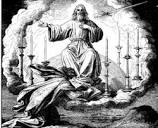
In today’s readings we have two revelations of the risen Lord. Today and for the next few Sundays, the second reading comes from the Book of the Apocalypse. This was written by someone called John, who was exiled to Patmos. He almost certainly was not John the Evangelist, as his Greek is apparently very different from that of the fourth gospel, though he probably belonged to the Johannine community. He was a Jewish Christian, who wrote in the literary genre known as apocalyptic literature, which conveyed a message of encouragement to a persecuted community that God will always triumph over evil. It uses colourful imagery, almost like a code, with dramatic characters and scenes, some of which are similar to the Book of Daniel. The vision of Christ, who is portrayed as a figure of majesty, brings words of reassurance. He was dead and now he lives for ever and ever. The seven lampstands, a very Jewish image, represent the seven churches mentioned in the Apocalypse. They are united as one in the figure of Christ; the number seven represents completeness in the bible.
Contrasted with this is the gospel appearance to Thomas. Through this disciple, who wanted concrete evidence of his master’s resurrection, we are given clear testimony of the reality of Christ’s risen body. By the time John’s gospel was written, docetism - the belief that Christ’s body only seemed to be human but was in fact an illusion - had begun to take a hold. Mark and Matthew’s resurrection stories are brief; Luke and John give a lot more detail. By the time the two last gospels were written, the evangelists probably felt it was necessary to give more credence to the reality of the bodily resurrection by relating Jesus’ appearances at greater length. Today’s accounts clearly proclaim the Jesus who is God Incarnate.
“I am the first and the last.”